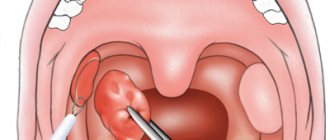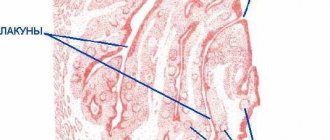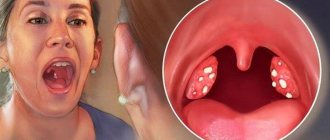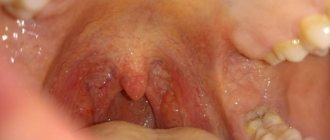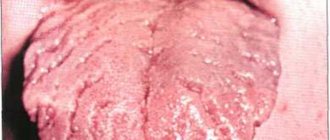Plugs in the palatine tonsils (or tonsils) are purulent accumulations in the lacunae of the tonsils. In medicine you can find other names for this pathology: purulent plugs, caseous plugs.
Most corks are white, but can have a yellow, brown or gray tint, depending on their composition.
Tonsil plugs may be soft to the touch or harder if they contain a large amount of calcium. Their size varies from a few millimeters to a centimeter. Both men and women are equally susceptible to their appearance, regardless of age.
Some patients mistakenly think that this condition does not need to be treated. But this is fundamentally wrong! The presence of purulent accumulations in the palatine tonsils contributes to the development of complications (not only in the upper respiratory tract, but even in the joints, kidneys and heart!).
Why does an accumulation of pus occur in the tonsils? How to treat tonsil plugs? And is it possible to carry out treatment at home? You will find answers to all your questions in our new article.
Tonsil plugs: causes
To find out the etiology of the occurrence of purulent accumulations in the tonsils, you need to understand what role the palatine tonsils play in the body.
The tonsils are an important organ of the human immune system, which is the first to stand in the way of bacteria and viruses that enter the body through the mouth. As soon as “strangers” reach the surface of the tonsils, they begin to intensify the production of leukocytes, which enter into battle with pathogenic microorganisms. As a result of such “battle actions”, dead leukocytes, bacteria, and epithelial remains accumulate in the lacunae of the tonsils. Over time, minerals accumulate here, and the contents of the lacunae begin to harden, forming caseous plugs.
The main cause of traffic jams is chronic tonsillitis. But they can also form in the palatine tonsils for various reasons:
- accumulation of staphylococci, streptococci, pneumococci and other bacteria;
- in people who have a weak immune system;
- frequent sore throats;
- the presence of herpes virus and fungi in the body;
- dental problems (caries);
- viral infections (flu, ARVI).
Each of the above reasons can provoke inflammation of the tonsils. The risk of accumulation of caseous masses in the lacunae of the tonsils is increased by unhealthy diet, smoking, and alcohol consumption.
Traffic jams do not form just like that, for no reason. They are a consequence of another disease and signal that an inflammatory process is underway in the body.
What can you do at home?
There is no need to remove whiteheads yourself, otherwise you can damage the mucous membrane and the infection will spread.
Self-medication is also strictly contraindicated.
Do not try to squeeze out pus without the skills: the discharge of pus may intensify and expand. Pustules will appear inside the tonsils, where there is no access. You should not make hot compresses, especially at night, drink hot drinks, such as milk, warm your throat with a blue lamp, or visit public places so as not to infect others.
This is acceptable if you have some experience and small traffic jams. How to remove a blockage in a child's throat? They can be removed:
- using language;
- cotton swab;
- washing the tonsils.
Caseous plugs or pus in the tonsils can be seen simply by looking at the throat in front of a mirror. They are usually white or yellow in the form of cheesy pieces on the throat in the area of the tonsils.
They are located in the lacunae - the internal cavities of the tonsils opened towards the larynx. These white or yellow pieces are the result of the immune system fighting the infection, essentially just dead cells and particles of tissue and blood, as well as the infection itself.
purulent plugs
Symptoms
Small accumulations, as a rule, do not cause significant symptoms. With large accumulations, the patient may experience the following symptoms of inflammation:
- bad breath;
- whitish dots are clearly visible on the surface of the tonsils;
- persistent sore throat;
- pain while swallowing;
- body temperature may be increased to 37-37.7 degrees;
- a feeling of discomfort at the site of accumulation of purulent masses;
- swollen tonsils;
- weakness, lethargy, general malaise;
- decreased performance;
- loss of appetite;
- enlarged lymph nodes;
- pain may radiate to the ears.
Traffic jams appear gradually, so in the early stages of the disease the patient experiences only discomfort when swallowing and a sore throat.
This condition is extremely dangerous for pregnant women! In addition to the fact that it has a detrimental effect on the general condition of the expectant mother, it can negatively affect the development of the fetus and, in the worst case, provoke a miscarriage. Therefore, it is extremely important to contact an otolaryngologist in time to receive competent recommendations on how to effectively treat tonsillitis during pregnancy and avoid complications.
Treatment in pregnant women
In pregnant women, the body is already weakened, as is the immune system. Therefore, purulent plugs are highly undesirable.
However, there are many recorded cases where pregnancy was successful even if the mother had large abscesses in the tonsils.
And yet they can lead to serious problems:
- Infection of neighboring tissues and organs – spread of infection throughout the body.
- Infection of the baby due to the spread of infection.
- Sepsis.
- Infection of a newborn. Sometimes during pregnancy there are no signs of fetal illness, but after birth any problems are identified.
Treatment is carried out in the same way as in other cases. But to avoid these problems you need to:
- Stay warm all the time, avoiding drafts.
- Wear scarves and hats.
- At the first signs of illness, consult a doctor.
- Maintain oral hygiene.
- See a doctor to know about the progress of pregnancy.
- Eat soft foods whenever possible (so as not to damage the tonsils).
Help yourself?
The biggest mistake most patients make is overconfidence that caseous plugs can be removed at home using improvised means. They use a whole arsenal of objects that are absolutely not intended for this: spoons, forks, toothpicks... At best, such amateur activities simply will not bring results, at worst, they will cause injury to the surface of the tonsils and provoke severe bleeding, swelling and inflammation! This will most likely be followed by a sore throat! Plus, if you press incorrectly with a hard object on the accumulation of pus, you can push it even further into the thickness of the tonsil.
Some people try to gargle, believing that gargling will bring relief. Yes, the feeling of discomfort in the throat temporarily passes, but the accumulations of pustules do not disappear, because the rinsing solution comes into contact only with the surface of the tonsils, and getting inside it is extremely problematic, or rather, impossible. Therefore, this method is also not effective.
The best method to get rid of traffic jams is to consult an otolaryngologist!
Treatment of children
Children develop pustules for the same reasons as adults. But the scale of the problem may be more serious.
The big problem is that the child does not understand how serious this is and can begin to squeeze out the abscesses on his own, and this is dangerous. Therefore, the disease must be dealt with by an adult.
If the plugs interfere, they must be removed in the hospital or at home. The last option is extremely dangerous and is not recommended. Instead you can:
- Gargle methodically to relieve pain (if any) or boost immunity.
- Seal the gaps with a laser (but not recommended for children).
- Suck out ulcers in the hospital using a vacuum instrument.
Possible complications
As already mentioned, the presence of clusters of caseous masses is not as harmless as it might seem at first glance. The danger of this condition is that pathogenic microflora from the lacunae of the tonsils can spread to other organs beyond the tonsils and provoke various kinds of complications:
- Peritonsillar abscess of tissue around the tonsils. A severe inflammatory process starts in the tissues around the tonsils. A patient with this condition experiences a sore throat. He can't help but feel like there's a foreign object stuck in his throat. There are difficulties with swallowing and wide opening of the mouth (trismus of the masticatory muscles). Periodically, the patient has a fever, and other unpleasant symptoms of intoxication of the body appear. In this case, only opening the peritonsillar abscess, sometimes with the simultaneous removal of the tonsils (abscessonsillectomy), will help improve the patient's condition.
- Cervical phlegmon is an infection of the tissue of the neck. The patient experiences severe pain at the site of inflammation, and the body temperature rises to 40°C. The danger is that a purulent infection can enter the blood and cause sepsis and purulent damage to other organs. The abscess can also descend into the mediastinum - the case where our heart is located. This inflammation is called mediastinitis. This is a disease with an extremely high mortality rate!
- Sepsis (blood poisoning), caused by infection in the blood. This condition is extremely dangerous for humans and requires urgent hospitalization.
- Kidney diseases.
- Joint diseases.
- Heart diseases.
Pathogens and causes
In 95% of cases, the causative agent of inflammation of the tonsils is beta-hemolytic streptococcus. Next come staphylococci, pneumococci, chlamydia, Haemophilus influenzae, viruses, etc.
The likelihood of developing an illness is always increased in the presence of chronic foci of infection in the nasopharynx: carious teeth, gingivitis, stomatitis, sinusitis, other chronic sinusitis, laryngitis, etc. The main role in whether a child gets sick or not belongs to the immune system. To activate opportunistic microflora, a decrease in immunity is necessary.
- chronic inflammation of the nasopharynx and sinusitis;
- lack of oral hygiene;
- decline in immunity;
- improper diet - monotonous protein foods, an abundance of carbohydrates, deficiency of vitamins in the diet;
- injury to the tonsils with the creation of a wound canal (for example, while eating, injury with a fork, fish bone, etc.), the wound canal in such cases attracts bacteria.
Treatment of tonsil plugs
When contacting an ENT doctor, the patient is offered conservative treatment, which includes washing the tonsils, physiotherapeutic procedures and drug therapy.
There are two methods of rinsing: removing pus with a syringe and hardware rinsing. The method using a syringe is used much less frequently if the patient has a strong gag reflex. The most effective method is to wash the tonsils using a vacuum method using the Tonsillor apparatus. In our ENT clinic, we use a special vacuum attachment for this, which has no analogues today! With the help of this attachment, it is possible to effectively and painlessly wash the entire contents of the lacunae of the tonsils, and improve the patient’s condition after the first session.
Treatment by an ENT specialist
If caseous plugs or pus in the throat appear very often, the immune system is noticeably weakened, the person often gets sick, inflammation of the tonsils is observed, it is worth contacting an ENT specialist.
Drug treatment of the disease consists of:
- prescribing antibiotics;
- vacuum suction of plugs;
- washing the tonsils with a syringe;
- physiotherapeutic procedures;
- laser sealing of gaps;
They are done in a hospital or in special medical centers. In rare cases, when pus appears all the time and becomes chronic, the only treatment option is to remove the tonsils.
Complete excision of the tonsils is rare; partial removal is more common to remove foci of infection, but leave most of the tonsils untouched to perform their main function.
Preventive actions
The best prevention of chronic tonsillitis is hardening the child. There should also be a fortified, balanced diet. Evgeny Komarovsky advises parents not to create greenhouse conditions, as this only increases the risk of getting sick. There is no need to forbid a child to eat cold food or drink water from the refrigerator, since cold is useful for increasing local immunity. Ice cream can soothe your throat.
Constant heat and pureed food increase the risk of disease. In the off-season, it is better not to take your child to places with large crowds of people, and not to travel by public transport unless absolutely necessary. But walking is a plus. In addition, prevention includes: personal hygiene - brushing teeth in the morning and evening, full treatment of emerging sore throats, compliance with the drinking regime, timely treatment of chronic inflammation of the ENT organs, avoidance of hypothermia.
Prevention
The easiest way is not to treat purulent plugs, but to prevent their appearance:
- Maintaining hygiene allows you to regulate harmful and beneficial microflora.
- Sore throat needs to be treated promptly and scrupulously so that complications do not develop.
- Treatment of the nose is also extremely important. A simple runny nose or sinusitis can easily cause congestion in the throat.
- Hypothermia is not recommended, especially if the body is weakened. You should always dress warmly and not skimp on heating.
- It is important to drink at least 2 liters of fluid daily. Any food should be chewed thoroughly to avoid rough pieces that can damage the tonsils.
Pus plugs can appear in the body of both healthy and sick people. They are not a sign of alarm, but only a reason for an unscheduled check with a doctor.
If there are no serious symptoms of illness, and they do not interfere, you can leave everything as it is and just take hygiene and food preparation more seriously. Pain and fever are much more serious symptoms and require immediate medical treatment.
Evgeny Komarovsky advises parents of children not to forbid their child to eat cold food or drink water from the refrigerator, since ice cream is a tasty and healthy medicine for increasing the local immunity of the larynx and tonsils. They can not only pamper the child, but also harden the throat. In children who drink warm drinks and eat pureed foods all the time, chronic tonsillitis is much more common.
Viral infections, once a child has become infected with them, cannot be treated with antibiotics - this increases the likelihood of developing chronic tonsillitis, and if the baby has a sore throat, it needs to be treated with a doctor, correctly, and not on the Internet according to the recipes of traditional healers.
The best prevention of chronic tonsillitis, which is easier to prevent than to cure, is to harden the child from a very early age, to follow the rules of a balanced and proper diet, rich in vitamins and microelements. Runny noses, even the most minor ones, need to be treated quickly and correctly, and caries, stomatitis and any other inflammatory processes in the mouth should be eliminated as soon as possible.
Physiotherapeutic procedures
They are prescribed during periods of remission. They reduce the activity and severity of inflammation. Most often prescribed:
- Ural rays have a bactericidal effect and improve local immunity.
- Laser irradiation has a pronounced antimicrobial effect, improves blood and lymph flow in the tonsils. There are 5-6 procedures per course.
- Ultrasonic aerosols – medications are injected deep into the lacunae using a special ultrasonic device.
- Antibacterial agents are used for therapeutic purposes: “Lizobakt”, “Hydrocortisone”, “Dioxidine”. In this case, the medicine settles in the gaps for a long time.


